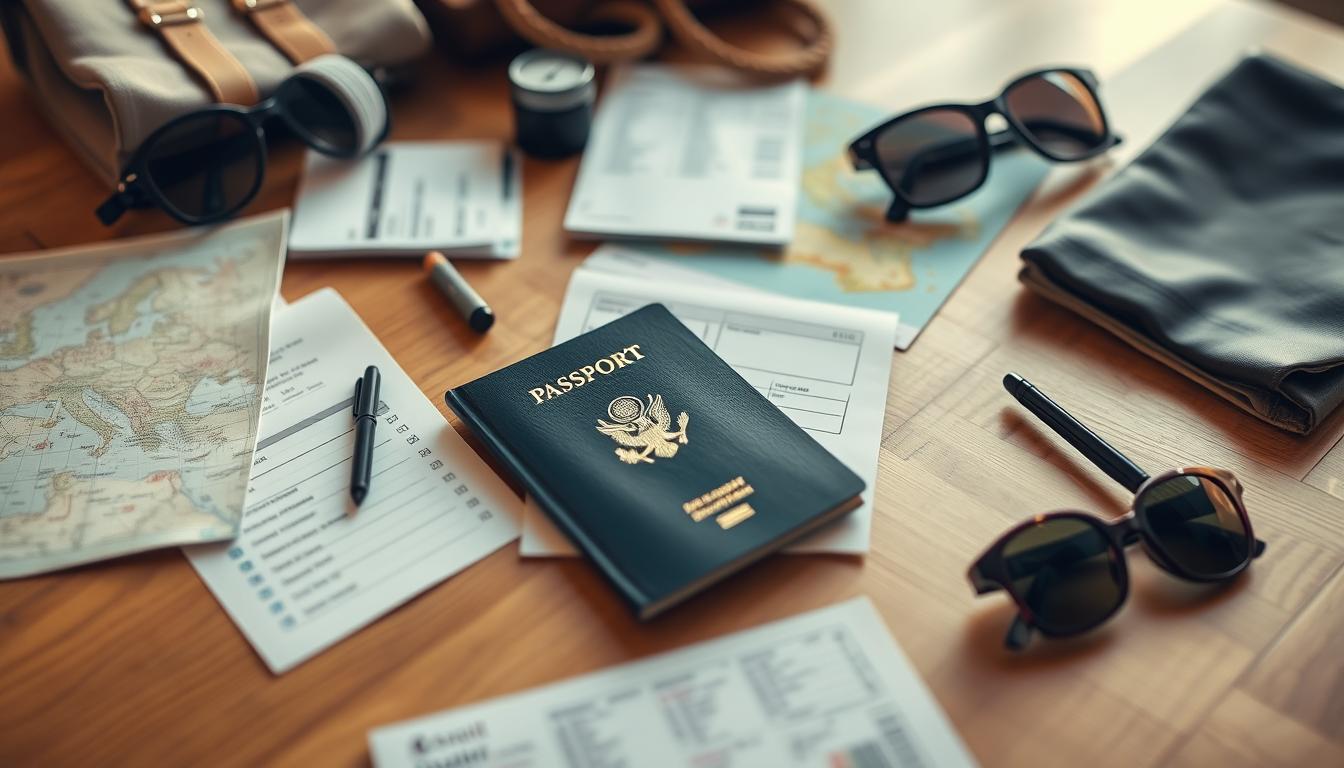Did you know that over 30% of travelers face issues at customs due to expired passports or missing documents? Preparing for a trip abroad doesn’t have to be stressful. With a well-organized checklist, you can avoid common pitfalls and focus on enjoying your journey.
This 12-step guide ensures you’re ready for anything. From securing passports and travel insurance to understanding cultural norms, it covers all the essentials. Planning ahead, ideally 3-6 months before your trip, can save you from last-minute headaches.
For example, some countries require passports to be valid for six months beyond your return date. Missing this detail could delay or even cancel your plans. Additionally, tools like the Wise multi-currency card simplify financial prep, making it easier to manage expenses abroad.
Key Takeaways
- Start planning 3-6 months before your trip for a stress-free experience.
- Ensure your passport is valid for at least six months after your return date.
- Invest in travel insurance to cover unexpected emergencies.
- Use multi-currency cards like Wise for seamless financial management.
- Research cultural norms and vaccinations specific to your destination.
Start with the Basics: Passport and Visas
Your journey begins with two critical documents: passport and visas. These are the foundation of any trip abroad. Without them, your plans could come to a halt before they even start.

Check Your Passport’s Expiration Date
Many countries require your passport to be valid for at least six months after your return date. For example, popular destinations like Thailand and Indonesia enforce this rule. Missing this detail could delay or even cancel your flights.
To stay updated, sign up for the STEP alert system. It provides real-time notifications about passport and visa requirements. This ensures you’re always in the loop.
Apply for Necessary Visas Early
Visa applications can take anywhere from three to six months to process. Start early to avoid last-minute stress. Expedited processing often costs $100 or more, so plan ahead to save money.
Here’s a pro tip: take extra passport photos. They’re handy for emergency replacements or unexpected visa applications. Also, consider using TrustedHouseSitters.com to maintain home stability while you’re away.
Secure Travel Insurance for Peace of Mind
Unforeseen emergencies can disrupt even the best-laid plans. Travel insurance acts as a safety net, covering everything from medical issues to canceled flights. It’s a small investment that can save you thousands in case of unexpected events.

Why Travel Insurance is Essential
Medical emergencies abroad can be costly. Policies starting at $3/day often include coverage for medical evacuation, lost baggage, and trip cancellations. During the COVID era, cancellation coverage has become even more critical.
Some destinations require proof of vaccination, which can affect your insurance eligibility. Always check CDC recommendations before purchasing a policy. Additionally, review your credit card’s travel protections—many cards offer built-in coverage.
Choosing the Right Coverage
Not all policies are created equal. Compare medical, baggage, and cancellation coverage to find the best fit. If you plan on adventurous activities like skiing or scuba diving, ensure your policy includes special riders for these cases.
Here’s a tip: Read the fine print. Some policies exclude pre-existing conditions or have strict claim deadlines. Investing in the right insurance ensures you’re prepared for any scenario, giving you peace of mind throughout your trip.
Stay Informed with State Department Alerts
Staying updated on travel alerts can make or break your trip. Real-time information about strikes, political unrest, or health advisories ensures you’re prepared for any situation. Surprisingly, 87% of travelers don’t use tools like the STEP program, missing out on critical updates.

Sign Up for STEP Alerts
The Smart Traveler Enrollment Program (STEP) is a free service that keeps you informed. Here’s how to enroll:
- Visit the STEP website.
- Create an account with your email and basic details.
- Add your trip itinerary, including destinations and travel dates.
Once enrolled, you’ll receive alerts about safety concerns in your destination country. For example, travelers in Europe recently avoided airport strikes thanks to timely STEP notifications.
Monitor Travel Restrictions and Warnings
Check the State Department’s country pages for the latest updates. Set alert checkpoints two weeks and one day before departure. This ensures you’re aware of any last-minute changes.
Also, register with your local embassy. This step is crucial for safety and can expedite assistance if needed. For instance, embassy registration helped stranded travelers during natural disasters in Southeast Asia.
Finally, remember that travel insurance claims often require proof of alerts or warnings. Staying informed not only keeps you safe but also protects your finances. By following these steps, you’ll travel smarter and more confidently.
Prepare Your Health: Vaccinations and Medications
Staying healthy while traveling starts with proper preparation. Your destination may require specific vaccinations or medications to protect you from local health risks. Start by checking the CDC website for up-to-date recommendations. For example, the yellow fever vaccine is mandatory in 27 countries, and malaria zones are clearly listed.

Check CDC Recommendations
Some vaccines, like rabies, require multiple doses over several days or weeks. Plan ahead to ensure you’re fully protected before departure. Additionally, research prescription rules for your destination. For instance, Japan bans stimulants like Adderall, and the UAE has strict opioid restrictions.
Don’t forget to schedule a dental checkup before your trip. Unexpected dental issues can be costly and inconvenient abroad. Also, be cautious about counterfeit medications in some regions. Always purchase from reputable pharmacies.
Pack a Travel Health Kit
A well-stocked health kit is one of the travel essentials you shouldn’t overlook. Include items like antibiotics, rehydration salts, and pain relievers. If you’re returning to the U.S., pack a COVID test kit to meet entry requirements.
“A small investment in health preparation can save you from major disruptions during your trip.”
Here’s a quick checklist for your health kit:
- Prescription medications (with copies of prescriptions)
- Basic first-aid supplies (bandages, antiseptic wipes)
- Over-the-counter remedies (antihistamines, antacids)
- Hand sanitizer and masks
By taking these steps, you’ll ensure your health is protected, allowing you to focus on enjoying your adventure.
Organize Your Finances for International Travel
Managing your money wisely is key to a smooth trip abroad. From avoiding blocked cards to minimizing fees, a little prep goes a long way. Start by notifying your bank and credit card companies about your travel dates. This simple step prevents 63% of cards from being flagged for suspicious activity.

Notify Your Bank and Credit Card Companies
Before you leave, inform your bank and credit card providers about your itinerary. This ensures uninterrupted access to your funds. Many banks offer online tools or apps to set travel alerts easily. For example, Chase and Capital One allow you to update your travel plans in just a few clicks.
Compare foreign transaction fees to save money. Cards like Chase Sapphire often have lower fees than others. If you’re using a Wise Multi-Currency Card, you’ll enjoy mid-market rates and local account details in over 40 currencies.
Carry Multiple Payment Options
Diversify your payment methods to avoid being stranded. Carry a mix of credit cards, debit cards, and some emergency cash. A good rule of thumb is to stash $200 equivalent in local currency for emergencies.
Here’s a quick guide to managing your finances abroad:
- Use ATMs strategically to avoid $5+ withdrawal fees.
- Link your card to ride apps like Uber or Grab before departure.
- Consider a cryptocurrency wallet for tech-savvy flexibility.
“A well-planned budget ensures stress-free adventures.”
By organizing your finances ahead of time, you’ll enjoy a seamless and worry-free trip. Whether it’s minimizing fees or ensuring access to funds, these steps are essential for every traveler.
Create Digital and Physical Copies of Important Documents
Losing important documents while traveling can turn your adventure into a nightmare. To avoid this, make digital and physical backups of all your essentials. This simple step ensures you’re prepared for any emergency.

Backup Your Passport and Itinerary
Start by scanning your passport, visas, and vaccine certificates. Email these copies to yourself and two trusted contacts. Use encrypted cloud services like Tresorit for added security. This way, you can access your documents even if your phone is lost or stolen.
Here’s a quick checklist for your backups:
- Passport and visa pages
- Vaccination certificates
- Hotel and flight confirmations
- Notarized consent letters for solo-parent travel
Share Copies with Trusted Contacts
In case of an emergency, having someone else with access to your documents can be a lifesaver. Share your itinerary and backups with family or friends. Also, create an embassy contact sheet with local addresses and phone numbers.
“Preparation is the key to avoiding travel disasters. Always have backups of your essentials.”
Finally, consider using an RFID-blocking organizer to protect your physical copies. These wallets prevent electronic theft of sensitive information. By taking these steps, you’ll travel with confidence, knowing your essentials are secure.
Pack Smart: The Ultimate International Travel Checklist
Smart packing ensures you’re ready for any adventure. Whether you’re heading to a tropical beach or a snowy mountain, having the right items in your bag can save time and stress. Start with a detailed list to avoid forgetting essentials.

Essentials for Your Carry-On
Your carry-on should include must-haves like travel documents, medications, and a change of clothes. A TSA-approved multitool is a lifesaver for unexpected situations. Here’s a quick checklist:
- Passport and boarding pass
- Medications and first-aid kit
- Chargers and power bank
- Reusable water bottle
For photographers, protect your gear with padded cases. Compression cubes help maximize space, while packing folders keep clothes wrinkle-free.
Clothing and Accessories for Different Climates
Adapt your packing to the weather. In hot climates, choose moisture-wicking fabrics. For cold destinations, layer with merino wool for warmth. Follow the “12 Outfit Rule” for long trips—mix and match versatile pieces.
Don’t forget comfortable shoes for walking. Laundry strategies like the Scrubba wash bag or hotel services keep your wardrobe fresh. Here’s a tip: Roll your clothes to save space and reduce wrinkles.
“Efficient packing is the key to stress-free travel.”
By planning ahead and organizing your bag, you’ll be prepared for any destination. A well-packed list ensures you have everything you need without overloading your luggage.
Plan Your Connectivity: Phones and Internet Abroad
Staying connected while abroad is easier than ever with modern technology. Whether you’re navigating new cities or staying in touch with loved ones, having reliable access to your phone and the internet is essential. Start by exploring your options to avoid hefty roaming charges and ensure seamless communication.

Check International Phone Plans
Many carriers offer international plans that include data, calls, and texts. For example, Google Fi provides affordable rates in over 200 countries. Compare these plans to traditional roaming, which can cost up to 70% more. If you’re traveling for a few days, a short-term plan might be the best way to go.
Consider an International SIM Card
An eSIM is a game-changer for frequent travelers. Services like Airalo allow you to download a SIM profile directly to your cell phone, eliminating the need for a physical card. Activation is simple—just follow the step-by-step guide provided by the service. This option is cost-effective and convenient, especially for multi-country trips.
Here are additional tips to enhance your connectivity:
- Rent a portable WiFi hotspot for uninterrupted access.
- Use a VPN to secure your information on public networks.
- Download offline maps like Maps.me or Google Maps for navigation without data.
- Configure a dual-SIM phone to manage local and home numbers.
- Enable emergency SOS satellite services for added safety.
“Staying connected abroad doesn’t have to be complicated. With the right tools, you can focus on enjoying your trip.”
By planning ahead, you’ll ensure smooth communication and access to essential information throughout your journey. Whether you choose an eSIM, portable hotspot, or international plan, these steps will keep you connected without breaking the bank.
Research Your Destination: Culture, Customs, and Safety
Understanding your destination’s culture and safety norms can make your trip smoother. Knowing local etiquette, laws, and areas to avoid ensures a respectful and stress-free experience. A little research goes a long way in avoiding misunderstandings or unsafe situations.

Learn Local Etiquette and Laws
Every country has unique customs and rules. For example, the “OK” hand gesture is offensive in Brazil, while Dubai has strict swimwear laws. Researching these things helps you blend in and avoid unintentional offenses.
Here’s a quick list of tips to keep in mind:
- Review local dress codes, such as avoiding sleeveless shirts in conservative areas.
- Learn basic greetings and gestures to show respect.
- Be aware of local scams, like taxi meters that overcharge.
Identify Safe and Unsafe Areas
Safety is a top priority when exploring a new destination. Use tools like Nomad List’s neighborhood safety maps to identify secure areas. Avoid informal taxis and stick to reputable services for added safety.
For more detailed information, check out the Best Practices for Traveler Safety guide. It provides valuable insights into staying secure while abroad.
“Cultural awareness and preparation are the keys to a smooth and enjoyable trip.”
By researching your destination thoroughly, you’ll be ready to navigate cultural norms and stay safe. These steps ensure your journey is both respectful and worry-free.
Finalize Your Itinerary and Confirm Bookings
Finalizing your plans is the last step before your adventure begins. Confirming your bookings ensures a smooth start to your journey. Double-checking your itinerary can save you from unexpected hiccups. Preparing for changes in your schedule keeps stress at bay. Ensuring all your bookings are in order is crucial for a seamless trip.
Double-Check Flight and Hotel Details
Start by verifying your flight details. Did you know that 22% of flights face schedule changes? Check your airline’s app or website for updates. Confirm your seat assignments and baggage allowances to avoid surprises at the airport.
Next, review your hotel booking. Use Google Street View to verify the location and nearby amenities. Ensure your reservation includes the correct date and room type. If you’re part of a loyalty program, confirm your status match opportunities for upgrades or perks.
Prepare for Unexpected Changes
Travel plans can shift unexpectedly. Here’s how to stay prepared:
- Learn airline rebooking priority strategies to secure alternate flights quickly.
- Cross-check visa and passport entry requirements to avoid last-minute issues.
- Adjust your sleep schedule to the destination’s time zone before departure.
- Calculate a contingency fund for unexpected expenses like rebooking fees or extra nights.
Flexible booking codes can also save you money and hassle. Look for options that allow free changes or cancellations. This way, you’re ready for any curveballs your trip might throw.
“Preparation is the key to turning potential travel disasters into minor inconveniences.”
By finalizing your itinerary and confirming all bookings, you’ll set the stage for a stress-free adventure. These steps ensure you’re ready to handle any unexpected things that come your way.
Conclusion: Ready for Your Adventure
With 12 steps and over 40 essentials covered, you’re now fully prepared for your trip. This guide ensures you’ve thought of everything, from documents to finances, so you can focus on enjoying the journey.
For added convenience, download a PDF version of this checklist to keep it handy. Don’t forget to use a Wise card for seamless financial management—it’s the best way to handle expenses abroad.
Before you leave, complete your pre-departure rituals. Arrange for plant care, pause mail delivery, and ensure pets are looked after. Double-check all documents 24 hours before your flight to avoid last-minute stress.
Embarking on international travel is more than just a journey—it’s a chance to grow and explore. With everything in place, you’re ready to make the most of your time abroad. Safe travels!


